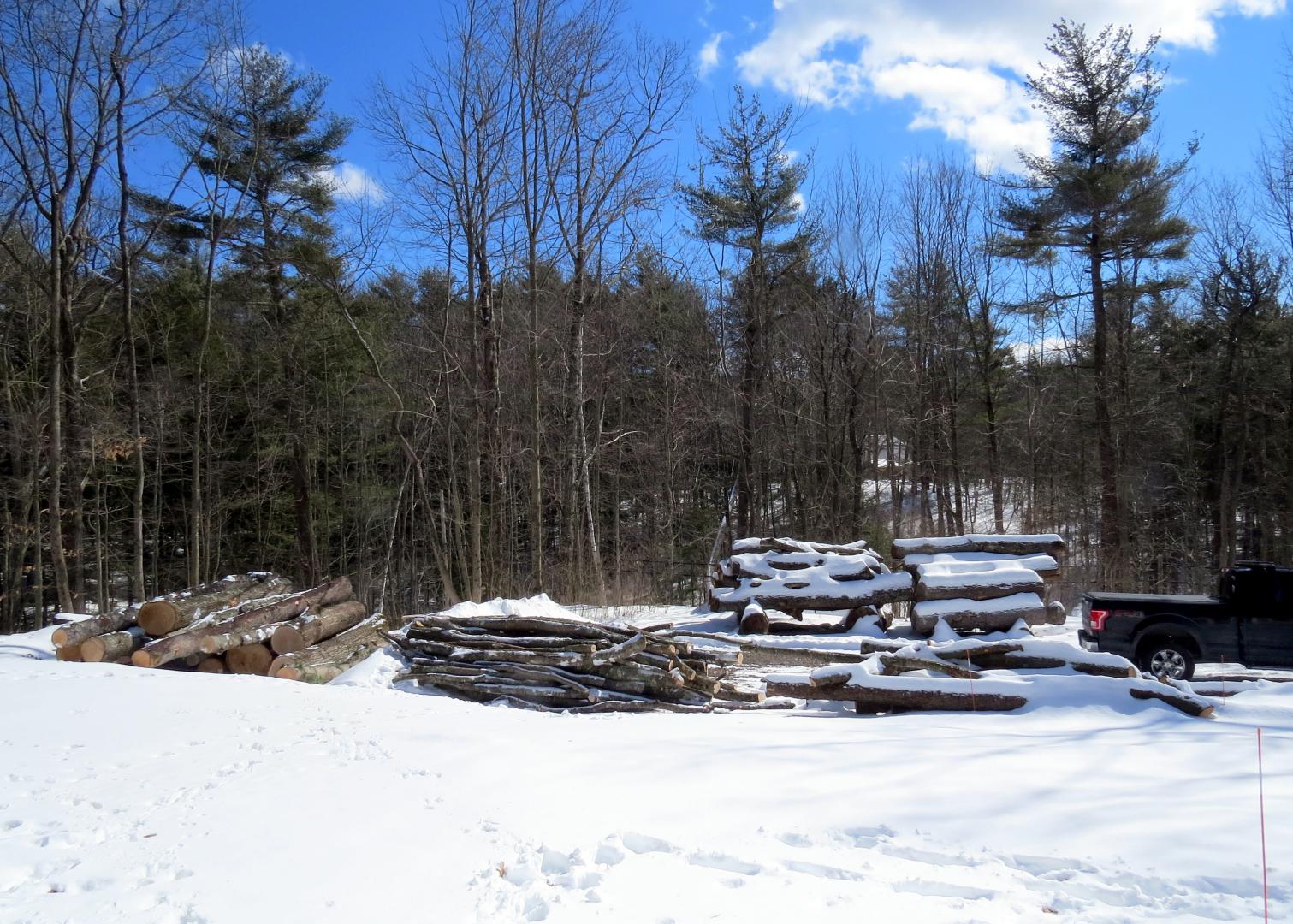
Harvesting Firewood
We burn wood to supplement our oil heat. Our house is pretty green, and very environmentally friendly. It was built in the mid-eighties as a replica of early New England settler’s bow house. The house is a center chimney, center stair, post and beam bow roof cape. Some of the early settlers used the hull of their ships as a roof for their houses. They didn’t need the ship after their trip here and they cut off the masts and flipped it over and built a house under it. They brought a roof with them that was waterproof. Pretty smart really… colonial recycling at its best. Very few original bow roof capes still exist, but many replicas were built especially in the eighties. Our house is a structural insulated panel (SIP) home. There are no 2×6’s in the walls and no roof rafters in the roof. The house was assembled from four by eight foot panels of hard foam sandwiched and glued between sheets of OSB (a plywood like building material). The panels are then routed out for wooden joining biscuits along the edges and glued together. In our case, the SIP panels are bolstered by a post and beam frame made of laminated southern yellow pine. The result is a super insulated and rugged home. The house is so airtight that there is a cold air exchanger to bring in outside air. We had to run a fresh air intake pipe directly to the woodstove so it would burn. The house is on a hilltop and faces south with lots of south facing glass including a twelve foot slider wall in the living room. In the winter, the sun’s transit is on its southern route with a low sun angle and the sun streams through the glass deep into the house generating significant solar gain. There are cold but bright sunny winter days when the house warms up to 72° from the sun. It is pointless and wasteful to keep the wood stove going. But… in the summer when the sun’s transit is much further north the sun passes over the top of the house, less sun streams in and the solar gain is minimal. Whoever designed and situated this house; knew what they were doing.
So, we don’t use as much heating oil as some and we don’t need as much firewood. However, this is offset by the fact that this is New Hampshire where we have long, harsh, cold winters. We have lived in this house for five years and are in our sixth winter as I write this in 2022. We have a lot of trees and a lot of them are big. We have done three major tree cuttings: one in the winter of 2016, one in the spring of 2021 and now winter 2022. Each time we took out massive trees and used a tree company with a crane. I’ve been felling smaller trees all along the way. We have not purchased any firewood since we bought this house.
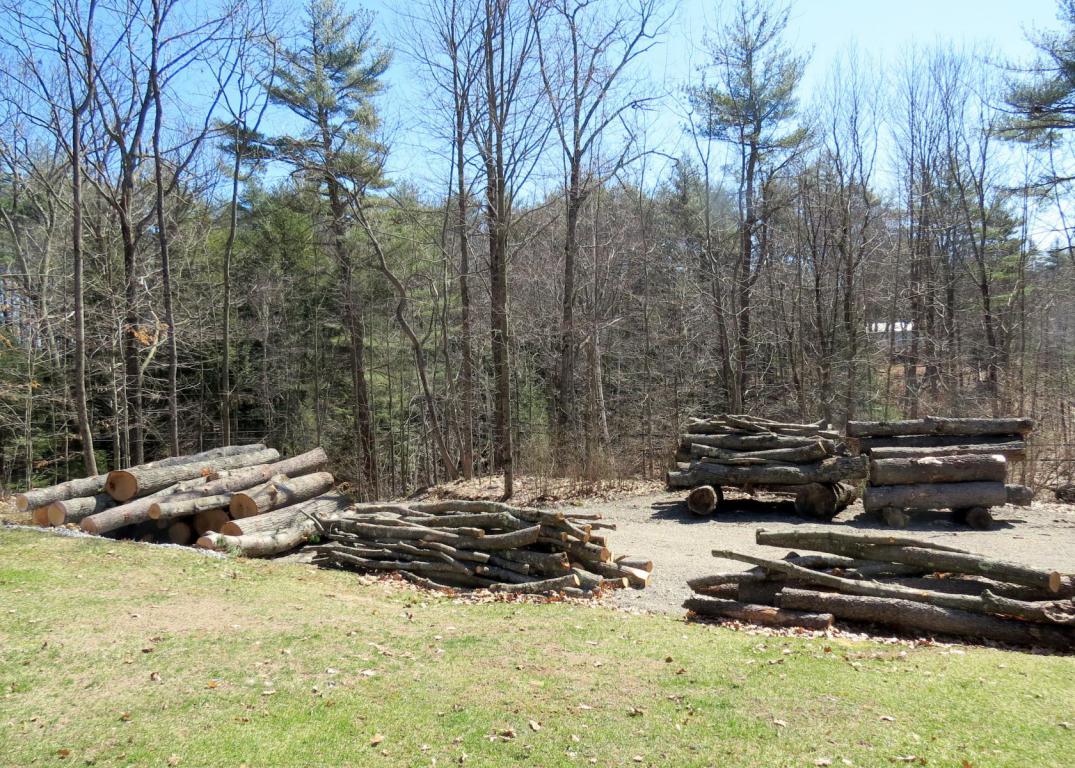
At the moment we have over twenty log length cords on the ground. Roughly half will go through our sawmill and the other half will be firewood. We have about four cords cut, split and stacked. We burn about two cords a winter so we are set for this winter and next with a several winter’s worth of log length ready to be processed. Over the years we have upgraded our system and made it easier to generate firewood. At our old house we stacked the wood under tarps and hand carried it to the house in canvas totes. We weren’t burning nearly as much so it worked OK. This house came with a crude woodshed that was about 75’ from the porch where we bring the wood in. We replaced the tarp door on the shed with a nice set of sliding doors. We started with what we knew… canvas totes and carried wood from the shed. It quickly became apparent that we were going to use a lot more wood.
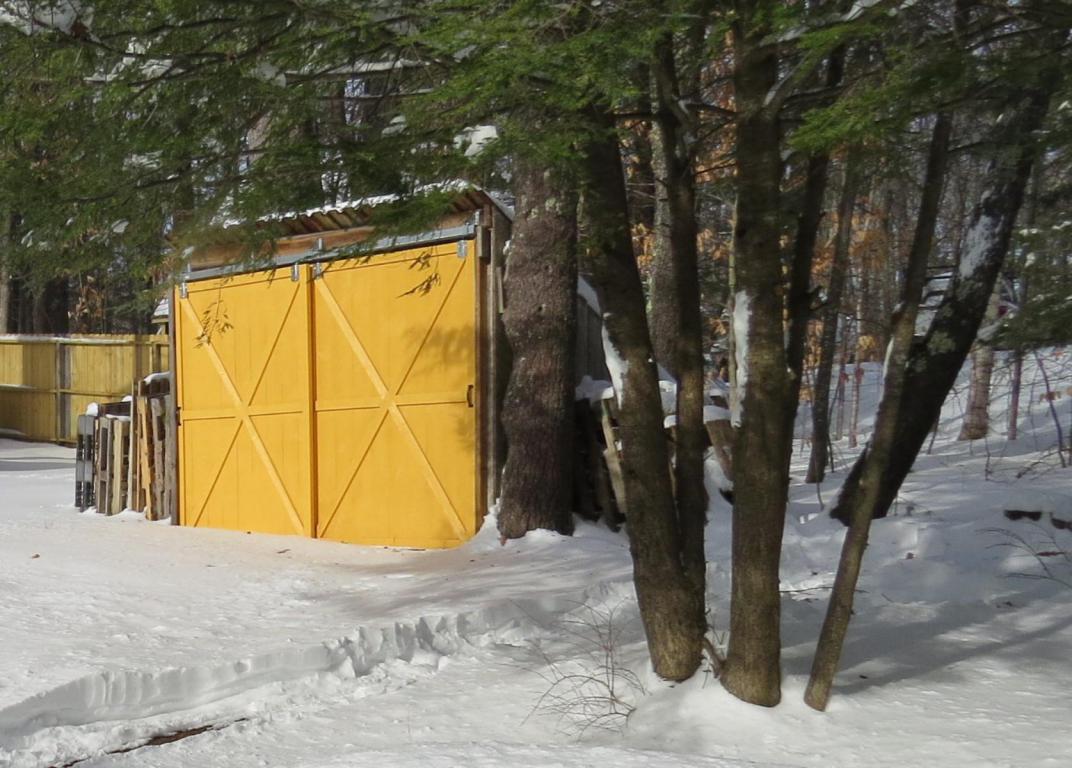
I bought a couple of new chain saws and a nice hydraulic wood splitter. I bought some wood racks and stacked about a cord on the screened porch that is just outside of where the wood stove is located. Open the slider next to the wood stove, grab firewood and feed the stove… nice! I did this before the snow flew. We only had to restock the porch once during the winter… we were headed in the right direction.
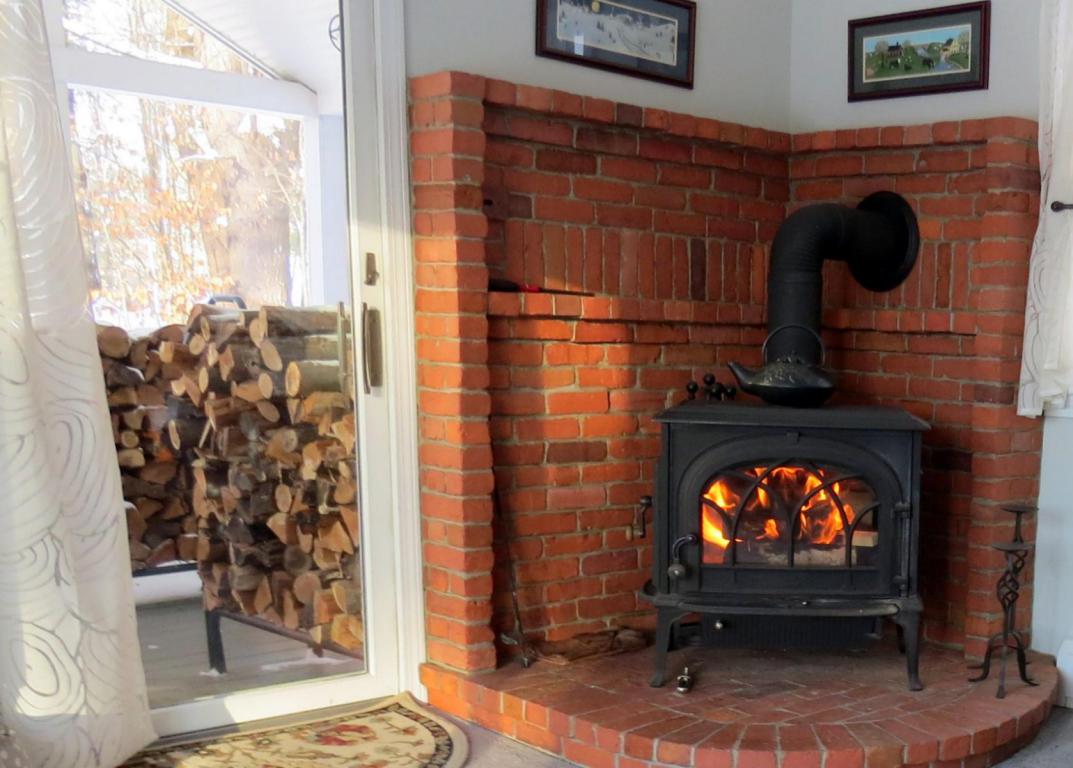
For a season or two I kept stocking the wood shed and moving ever increasing amounts of wood with a wheelbarrow and a heavy duty garden wagon before winter. A couple of times I filled up the back of my pickup truck and moved the wood that way. We were still running out of wood on the porch before spring. I bought a half dozen IBC totes to store the wood. IBC totes are metal cages that have an integrated pallet on the bottom. They come with a big plastic tank in the cage which you don’t need for firewood. The trick is to find used IBCs for a decent price, get rid of the tanks and notch one of the sides so you can reach in to stack and remove the wood. The totes are roughly a four foot cube and hold just over a third of a cord. If you have a fork lift or a fork bucket for your tractor (we do), you can move a third of a cord at a time. It is also prudent to place the IBC on a pallet to keep it off the ground… which increases the life of the tote.
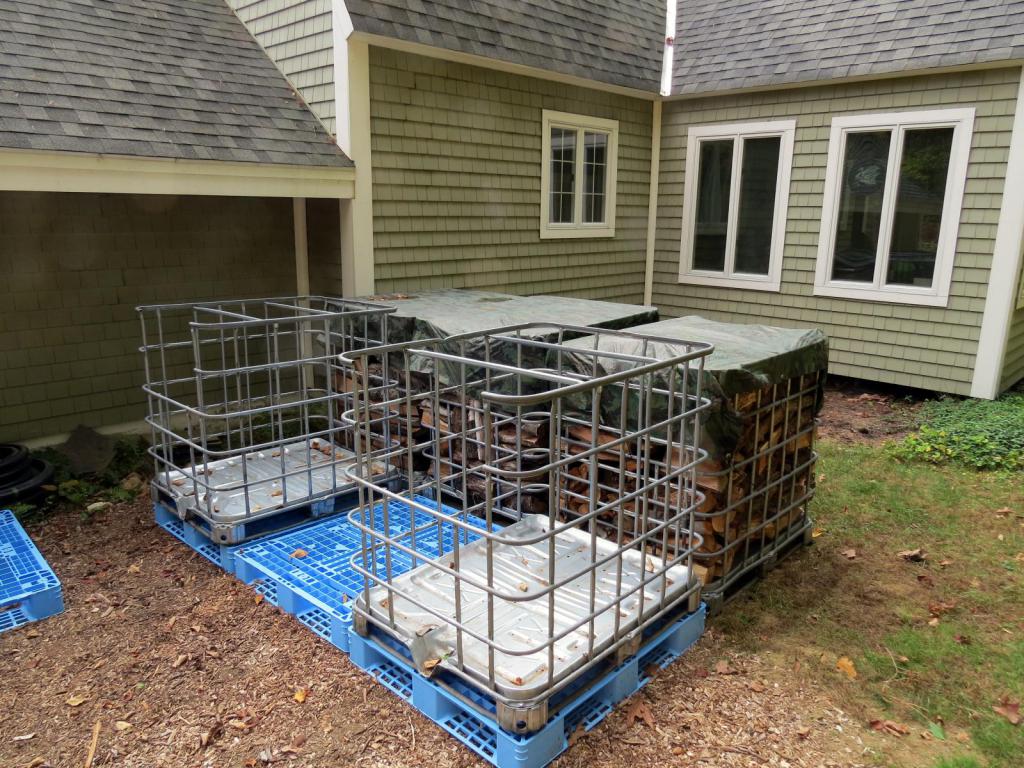
I bought my first modern tractor with a front end loader in the spring of 2020. It is a 26hp Kubota B series compact. It is a great tractor, but with limited lifting ability. The tractor is rated for about 1000lbs and can be pushed to lift maybe 1200lbs. A full tote of green firewood, especially oak, weighs more like 1500lbs. With loads like that the little Kubota was operating on the edge. And, to make matters worse its narrow footprint running on hilly property… made it quite tippy and daunting to drive. I drove with the totes no more than a few inches off the ground. I knew there was a bigger tractor in my future. With that said, the little tractor is still a very useful piece of equipment. With its 4’ wide footprint it can get into tight places and squeeze between trees. It is an excellent machine for tree work. I built a wooden crate on top of the ballast box. It holds gas, oil, chains, a grapple hook, a peavey and chainsaws… all the stuff for harvesting. I often chain felled trees and drag them out of the woods with the tractor.
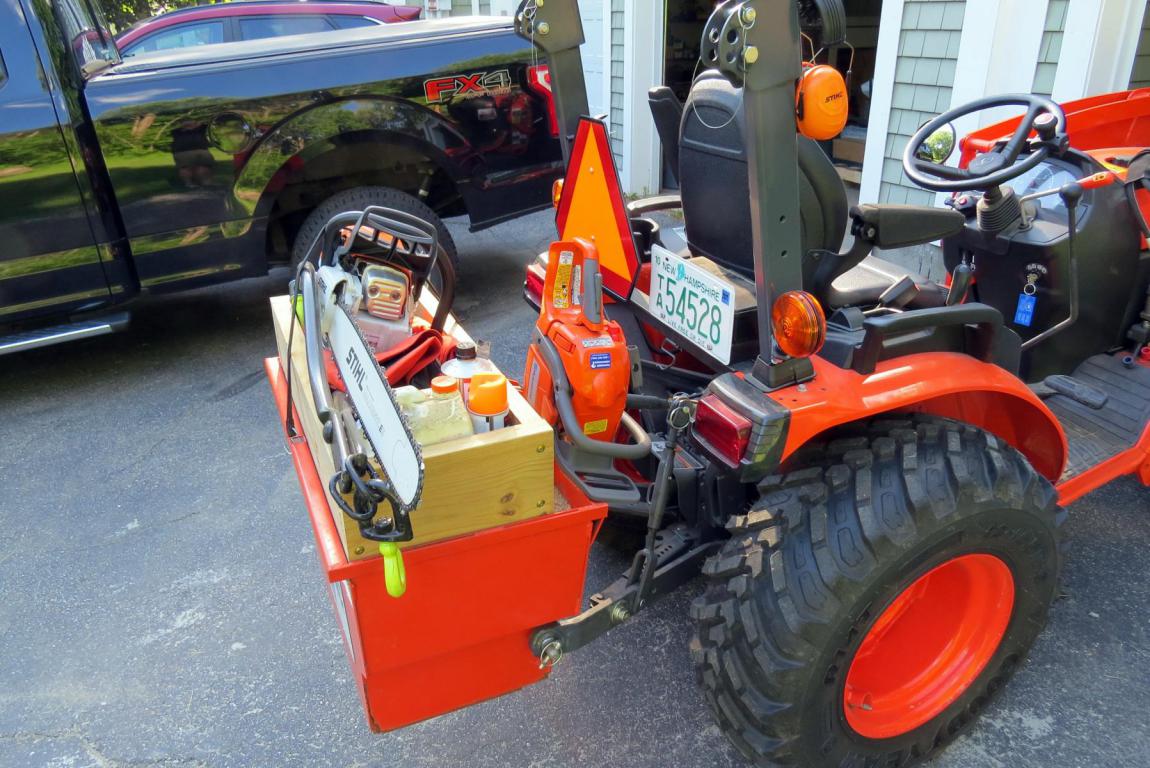
The idea of using the IBC totes makes sense and many, many firewood users have resorted to using them. As I have said elsewhere, I enjoy the challenge and process of generating firewood. But streamlining it and saving steps still makes sense. When we first bought this house, we felled trees, cut them to firewood length rounds and split them into usable wood. We then filled up my pick up and drove it to and stacked it in the woodshed. A year or so later we took the wood out of the wood shed, put it back in my truck and drove it to the porch. We were moving and stacking it several times. Now, we cut and split and stack the wood in the totes and cover it with a tarp. When the time comes, we move the totes with a tractor and unload them directly onto the porch. Another huge benefit of this system is that we can tag the totes with the date they were filled and use them in the correct order: oldest to newest. Woodsheds always create a constant struggle to get to and use the driest wood first. It’s an endless problem; the driest wood in the shed is invariably behind the more recently stacked wetter wood. Our woodshed is no longer used for wood; we store tractor implements and equipment in it.

Speaking of implements… my forklift bucket is one of the most useful and frequently used implements I own. I unload deliveries from trucks (including things I bring home in my pickup), I move the firewood totes, logs, brush, boulders, etc. My sawmill that came out of Canada was brought on a tractor trailer truck that could only get to the beginning of our road. The “Lane” is simply too narrow with tight turns for a TT unit. The sawmill was on two pallets that weighed about a 1000lbs each. No problem… I drove the tractor to the truck and picked the pallets right out of the trailer with my fork bucket and drove it the quarter mile back to my house. And, I strongly recommend that you buy a real fork lift bucket as opposed to the clamp on tines. Yes, the clamp on tines are cheaper but sit the bucket’s depth ahead of the lifting pivot point further reducing lift capacity. They are also notorious for bending the bottom of your bucket into a curve. We jokingly call it a “bucket smile”. It goes without saying that a curved bucket is a lot harder to grade with or plow snow.
This summer (2021) I patiently waited for the local Kubota dealer to get a suitable tractor for my heavy lifting needs. It is a real farm tractor, 60hp M series with a wide and stable stance and lots of power. I would not have purchased the bigger tractor just to move the firewood totes; it would not have been cost effective. The big tractor was mostly driven by my need to lift heavy logs onto the sawmill. I bought a log grapple for it. It clamps onto logs, lifts them and sets them down gently. I can pick big log, up to about 3000lbs or a grapple full of smaller ones at the same time. You can also dig with it. Have an annoying bush taking over part of your yard? Sink the jaws of the grapple around the bush, close down on it and yank it out of the ground. You can do the same thing with sizable boulders. These are tasks that would take hours with a shovel and pry bar, would be exhausting and you would still have to deal with moving them after you freed them from the earth. The grapple bucket has been a Godsend. Put the fork lift bucket on the big tractor and it easily and safely moves the loaded totes. There is a time and place for the right equipment.
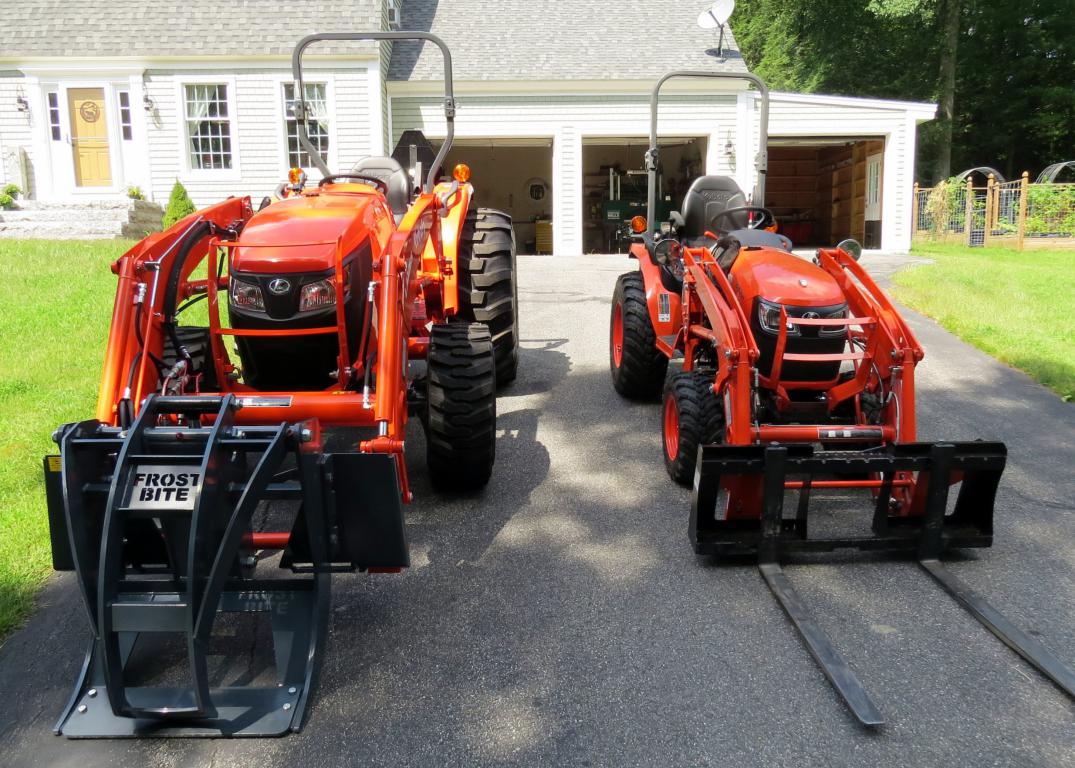
So, at this point we have 16 IBC totes, enough to hold over six cut, split and stacked cords. If we get them all filled this summer, which is feasible, we will be three years out in seasoned, usable firewood. That is one of our goals for this year. Then we will refill the empty totes each spring to stay well ahead of demand and increase drying time.
We still have a significant number of logs in the new driveway and work area. About half are slated for firewood (far more than the totes will hold) and the straighter, cleaner logs are going to go through the sawmill to get turned into lumber. We kept all the logs from the tree work. Even the pine logs that are not straight enough for milling; will end up in the wood stove. We are a zero waste operation. Many people are reluctant to burn pine because of the creosote. If it is seasoned properly and you run your stove fairly hot… you will be fine. Pine is actually great for starting a fire, it lights easily and burns quickly and hot. I have burned a lot of firewood across my long life and never had a chimney fire. I clean my chimney every year and except for the pipe that comes directly out of the stove, the chimney is very clean. I take off the stove pipe, shake it out and run a brush (for no apparent reason) down the chimney. The sawmill will also produce tailings or cut off edges of logs. This will provide us ample kindling wood to start our stove.
I need to get a lot of the logs out of the new driveway/work area. I need room to set up the sawmill and work around it. I’m going to clear the east end of our property so we have space to stack the logs and sawn lumber for drying. The trees in this area are in rough shape. Many are dead and some have fallen over on their own. I will clear it this spring. I have a stump grinder (more on that in another essay) that makes up to the little Kubota and will remove the stumps. Then we can begin to move the firewood (and sawn lumber) out of the work area. We have a lot on our plate!


Recent Comments